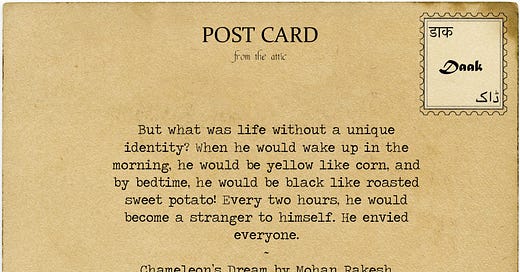The Futility of Envy: Mohan Rakesh’s Short Story, Chameleon’s Dream
Self-doubt often brings with itself an added burden of social comparison and envy. We look within our social circles and find that our friends and relatives are full of admirable qualities and success stories. We shrink and pale in comparison, wishing that we could magically transform ourselves and our lives. In fact, these feelings of inadequacy and dissatisfaction are so universal and pervasive that even children’s stories warn us about the futility of envy.
A delightful story, “Girgit Ka Sapna” (Chameleon’s Dream) by Mohan Rakesh, explores this theme using the insecurities of a chameleon who is tired of his ever-changing persona. The story begins thus:
There once lived a chameleon. Fat and well-fed. He lived in a jungle. There was no shortage of food. Despite that, he was sad. He felt that everything and every being had its own distinct colour. But he did not have his own colour. A short while back, he was blue, now he would turn green. From green to purple. Purple to brown. Brown to black. What kind of life was this! It was true, this ability protected him. He was also able to hunt for food because of it. But what was life without a unique identity? When he would wake up in the morning, he would be yellow like corn, and by bedtime, he would be black like roasted sweet potato! Every two hours, he would become a stranger to himself. He envied everyone.
Rakesh was a pioneering figure of the Nayi Kahani or New Story movement that brought a breath of fresh air to Hindi Literature in the late 1950s and 60s. Instead of dwelling on grand and imagined themes, it focused on the small, lived realities of the middle class. In this story too, Rakesh uses the example of a chameleon to explore this common malaise so widespread in our society.
The chameleon is blessed with an incredible ability to take on any hue in his surrounding, yet envies the qualities of other creatures in the jungle. One night, as he is falling asleep, he magically transforms into a snake, whose shiny, slithering skin he admires. As he sets out to explore, he is attacked by a mongoose and forced to hide since he can no longer camouflage himself. So, he wishes that he were a mongoose instead. Once again, he is magically transformed into a mongoose. In his excitement, he runs and jumps around but his fur is caught in a prickly thorn on the branch of a tree. Hanging mid-air, he wishes he were a tree so he could enjoy swaying in the breeze instead of crawling like a snake and jumping around like a mongoose. Again, the chameleon’s wish is granted and he turns into a tree. Just as he begins to enjoy his new identity, two pesky crows descend, defecate on him, and scratch his branches. Ashamed and pained, the chameleon wishes he could turn into a crow.
His final wish is granted and the chameleon takes flight with other crows in the open sky. Suddenly, a crow next to him is struck down by a stone. When the chameleon scans the ground, he sees a couple of boys taking aim with their slingshots. He shuts his eyes in fear, full of repentance and longing for his old body. Suddenly, he wakes up and realises it was only a frightening dream. He sees snakes, mice and bats emerging from their homes and quickly changes colour to conceal himself. The story ends with the chameleon having learnt an important and timely lesson: “he was thankful that he was a chameleon and nothing else.”
There is a powerful message lurking underneath this seemingly simple story. Envy and regret often blind us to our own unique gifts and abilities. Like the chameleon, we focus on admiring the skill or talent of other people, belittling ourselves in the process. Let the parable of the chameleon serve as a reminder to cherish our own unique talents and skills.
You can read the original story in Hindi here.



